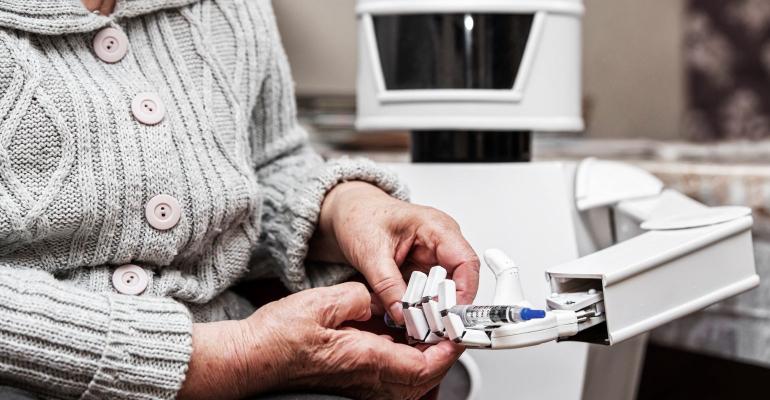Toward the end of January 2023, the World Health Organisation (WHO) said COVID-19 continues to constitute a public health emergency of international concern. However, it also said the pandemic is probably at a transition point.
The virus is still making waves, periodically surging across Europe. It is now compounded with a seasonal spike in the flu and respiratory syncytial viruses, creating a ‘Tripledemic.’ More people are landing in hospitals for testing, treatment, and care. The WHO in Europe and the European Commission have previously alerted governments and healthcare systems to be prepared.
To make matters worse, Europe’s ongoing healthcare labour challenge means staff will be spread even more thinly, caring for more patients during this triple threat. About two-thirds of clinicians and nearly 70 per cent of decision-makers agree that physicians and caregivers are overextended during their shifts. Staff is beginning to vote with their feet. Strikes are happening across Europe with walkouts seen in the UK and France to cite two examples.
Given the environment, it is not surprising that healthcare workers are leaving the field in droves across the globe. McKinsey’s global nursing survey revealed that in five out of seven countries surveyed, between 20 to 38 per cent of respondents said they wanted to leave their current direct-patient-care role. In another report, the WHO found that an ageing workforce among doctors posed a serious risk to countries in Europe and central Asia, along with staff shortages as well as recruitment and retention problems amongst others.
Nurses have carried the brunt of the burden, burning out, walking out, or retiring. Retaining nurses, doctors and healthcare staff is always crucial, but it is amplified in times of crisis, such as the threefold viral onslaught Europe and much of the world are currently facing. The industry needs to do better, but how?
Keep turning to technology solutions
The use of technology solutions in healthcare accelerated during the pandemic. And it is moving forward, bringing along the lessons learned. Technology creates the capacity to optimise staff, increase efficiency and minimise errors.
Take mobility solutions; with a secure multi-purpose mobile device, it is possible for staff to access patient data from anywhere. This eliminates the need for nurses to run to and from stations, minimising the risk of human error and ultimately making time at the patient bedside more efficient. Clinicians agree, with eight in 10 saying clinical mobility increases their workflow accuracy and precision, reduces preventable errors and raises the focus on patient care and attentiveness.
A mobile device, like a healthcare tablet or handheld computer, lets caregivers monitor patient vitals in real time or be alerted to issues so they can make the right decision and take the right action in the moment. It literally optimises patient care in the palm of caregivers’ hands.
Improving connectivity between staff is another key benefit technology brings. One of the most effective tools is a unified communication platform — software application that augments mobile devices like mobile computers and tablets with the features and functions of many different apps including texting, calling, task and workforce management.
The connection provides better collaboration, streamlines time management and shift handovers, and ensures optimal care in tests, samples, medications and records. In fact, most healthcare executives (87 per cent) agree patient care would improve if nurses, clinicians and non-clinical healthcare workers had collaboration tools and healthcare apps.
Additionally, location solutions like radio frequency identification (RFID) tags and readers track, trace and monitor the status of patients, staff and assets such as medical equipment, blood samples or medications throughout the hospital, minimising lost items, errors and time. About four in 10 healthcare executives say they currently use location technologies across hospitals. Nearly all (98 per cent) say they plan to use such solutions in the next five years to track patient flow, medication, equipment and staff operational efficiency.
Technology frees up capacity for nurses, doctors and staff. By alleviating administrative burdens while improving communication and collaboration, they have more time to focus on what matters most — caring for patients. The ability to improve the working environment can reduce burnout and ultimately enhance positive patient outcomes. Nurses want to provide care in great workplaces where they can do their best work. But they need breaks to rest, eat, talk with colleagues, and catch up on phone calls and messages. Burnout is negatively impacting nurse retention.
Moving ahead with AI and Big Data
Beyond mobility and communication technology, artificial intelligence (AI) is a growing part of the healthcare ecosystem. There are a growing number of healthcare apps available that are powered by AI. They feature mental health support, the ability to check and record weight and blood pressure, use video to report symptoms, create health recommendations, provide nutritional insights, and much more. These apps also give healthcare professionals insights into patients’ daily patterns and needs, enabling better guidance for staying healthy.
We can also expect to see new AI applications giving healthcare professionals alternative training options with naturalistic simulations, insights into diagnosis through cognitive technologies, early disease detection via screening reviews, patient movement alerts through wearables and analytics about potential treatment.
The transformational power of technology
The pandemic disrupted the healthcare model. It accelerated the role technology plays in healthcare by proving its ability to create capacity. Let us continue learning from and building on those lessons. While technology may not be able to solve all the problems within the healthcare ecosystem, it does make important and needed improvements for doctors, nurses, and ultimately the patients in their care.
Thomas Duparque is a Healthcare Specialist EMEA at Zebra Technologies.
____
Back to Technology


